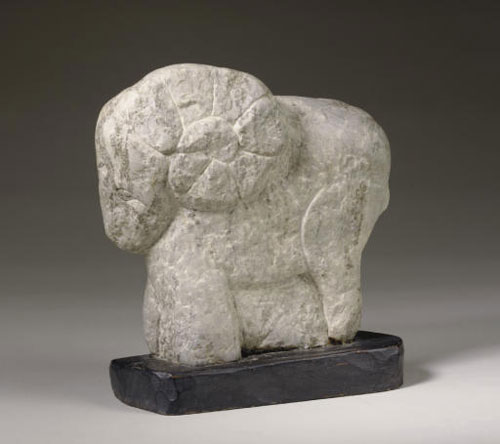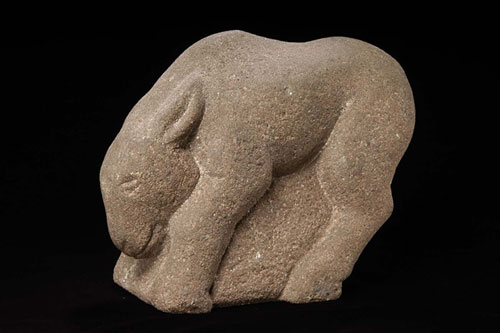
 Sculpture News at SculptSite.com
Sculpture News at SculptSite.com
John B. Flannagan Sculpture |
| California-Literary-Review By Holly Hunt The Forgotten Sculpture of John B. FlannaganEmbrace all living forms, each for its plastic adjustment to a theme - living for warmth. No narcissistic worship for humanity - contra, the stately dignity of the Mountain Goat, the ironic pensiveness of the apparently thoughtful Monkey, and (in his greater moments) the timeless yet rebellious patience of the Ass. - John Bernard Flannagan I'm not writing this appreciation of sculptor John Bernard Flannagan (1895 - 1942) on the occasion of a retrospective of his work, or the publication of a new monograph, though I wish I were. I don't generally respond all that powerfully to sculpture, but I was deeply moved the first time I saw images of his work (sadly, I've never seen any of it in person). His sculptures, like his wonderful Elephant of 1929-1930, or his Chimpanzee of 1928, were often carved directly from the rock; they are both roughhewn and elegant, radically simple but powerfully emotional, immediately evoking both the natural forms of the stones from which they are made, and the living creatures they represent. It's sad to think of them languishing in obscurity. I admit I first thought of writing about Flannagan because of the parallels to Weldon Kees - both came from the Midwest, both struggled with obscurity and poverty, both died as suicides. But Kees, with his cult following, seems like a rock star compared to the all-but-forgotten Flannagan. Flannagan (with two ns - this is important) was once celebrated, in a minor way, for helping introduce direct carving, also called taille direct, into American sculpture - the practice of working right on the stone itself, letting the carving process influence the final shape, rather than preparing a model in another medium and reproducing it in stone. Yet since his suicide - after a difficult life marked by many losses and terrible poverty - Flannagan seems to have largely dropped out of the sight of everyone except those with a professional stake in the history of American art. The Whitney Museum of American Art, the Brooklyn Museum of Art, the Hirshhorn Museum, and the Smithsonian American Art have significant holdings, but the phrase "not currently on view" seems to pop up frequently in researching them. The Figge Museum in Davenport, Iowa, has a lovely carving of a sleeping fawn. Smaller pieces seem to come up at auction fairly frequently and auction houses are one of the chief sources of images online, though at least one lists a piece as having "not sold." There doesn't seem to have been a retrospective since the one at the Museum of Modern Art that opened shortly after his death in 1942 (I just purchased a copy of the catalog on Abebooks for under twenty dollars). The most recent full-length study of his work I could find reference to was an unpublished dissertation submitted to the University of Minnesota in 1965. Even his name works against him - the Wikipedia entry for "John Flannagan (Sculptor)" begins with a note: "Not to be confused with John Flanagan (sculptor)". The other John Flanagan (with one n), may not be a household name, either, but in 1932 he was responsible for one of the more familiar examples of three-dimensional design in this hemisphere - the U. S. quarter dollar coin. The other Flanagan, born in 1865, spent five years as a studio assistant to Augustus Saint Gaudens, perhaps the most celebrated and successful of all American sculptors, and enjoyed a long career marked by numerous government commissions, as his work on the quarter dollar suggests. Though much older than John Bernard Flannagan, he outlived him by ten years. As I mentioned above, John Bernard Flannagan (with two ns) was, like Weldon Kees, a son of the Midwest, though the outlines of his early life are a much starker essay in prairie gothic. He was born in Fargo, North Dakota, in 1895; when he was five, his father died, and his impoverished mother gave up her children to an orphanage. When he created an image of a child leaning against its mother, he wrote, "As a boy I very rarely saw my mother, and I think that the whole psychological story of what that means to a child is implied in this piece." Flannagan managed to reach the Minneapolis School of Art, but dropped out to join the Merchant Marines when the U.S. entered World War I. In 1922, after leaving the Merchant Marine, he resumed his artistic training in New York, and soon found a mentor and patron in painter Arthur Bowen Davies. Davies, no longer a household name either, was one of the organizers of the famous Armory Show of 1913 and was associated with the painters of the Ashcan School, though his dreamy symbolist landscapes bear little resemblance to their gritty urban canvases (he was also, apparently, a longtime bigamist). Davies hired Flannagan to work on his farm in Rockland County while schooling the younger man in art. Later, Flannagan was provided with a stipend by a New York gallery, and Guggenheim fellowships allowed him to spend the early thirties in Ireland, where he would scour the fields for stones whose forms called to him. But the later thirties brought two car accidents, the second of which is said to have involved a head injury. His suicide followed a divorce and a stint in a mental institution. "The story has unfolded to its tragic dénouement, and may someday be told - portrayed in the mood and with the complex overtones of a Dostoyevsky character," wrote Carl Zigosser in the Museum of Modern Art catalog. His work, especially his use of direct carving, shows his affinity for the primitivist strain in modernism, and his animal sculptures in particular often seem almost totemic, charged with the living spirit of the creatures they represent. The Museum of Modern Art catalog contains immense riches in this vein - the Monkey and Young of 1932-33, the Head of a Child, emerging from a round moon-like stone, of 1935, the Restive Acrobat (another monkey), and the Frog, both of 1938. Even the insect kingdom gets its tribute, with Little Creature, a 13-inch high grasshopper carved from bluestone in 1941, not long before its creator's death. Flannagan's human figures, like the New One of 1935 (in the Minneapolis Institute of Arts) or Jonah and the Whale: Rebirth Motif of 1937 (at the Brooklyn Museum), often deal with archetypal themes of birth and regeneration, as their titles suggest. Flannagan's ideal was one of simplicity and purity, of an integrity of form and material purged of the coldness that sometimes seemed to afflict modern art: "Pure abstraction is dead," he wrote. "Make it come alive by the use of living form. Warm the cold geometry of abstraction with a naturalism in which the superficial and accidental have been eliminated by their union with pure form." The same passage continues with the assertion that "A thing should never be finished-should rather always be in a state of becoming." That sense of life in process - and of art itself as a life process - infuses all of Flannagan's work. I can only hope that his work is still a "state of becoming" in another sense - that it will continue to be discovered and enjoyed. Zigosser wrote in 1942 of Flannagan's "disinterested and truly mystical passion for humility and anonymity" and of how "he would have liked nothing better than to have had his work merge into the great anonymous plastic tradition of Egypt or medieval Europe." Perhaps Flannagan would have enjoyed the irony of having his name obscured by the name of a sculptor whose work really has become part of the fabric of daily life. But I still hope readers of this blog will remember it. |
 An absolutely enjoyable read courtesy of Holly Hunt. Sculpture and time again thrown directly at us... Quite nicely done direct stone carvings by sculptor John B. Flannagan! |
 John B. Flannagan (1895-1942), Standing Ram, Executed circa 1927-39 carved stone 9 1/2 in. (24.1 cm.) high on a painted wood base 1 1/4 in. (3.2 cm.) high Image source: Christie's |
 "Donkey" by John B. Flannagan |
More Sculpture News ....
Submit your SCULPTURE NEWS.
It's easy, just send us an e-mail
(click on Submit News in the left menu) with your pertinent information along with images, we'll take care of the rest. Sculpture makes our world a much better place in so many ways!
SculptSite.com, along with Sculptors and their creative genius all helping to bring the beauty and message of Sculpture to a hurried world.


